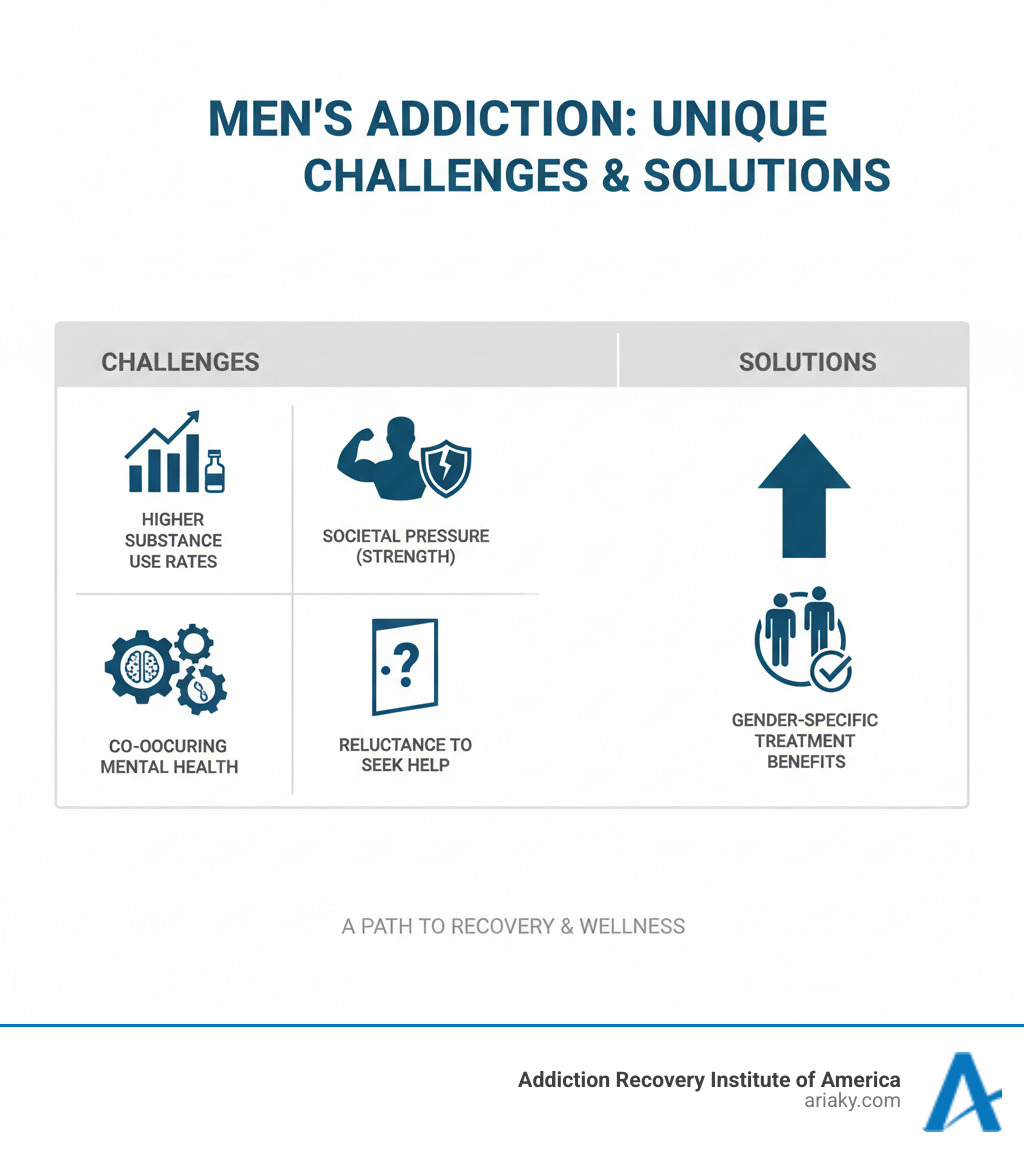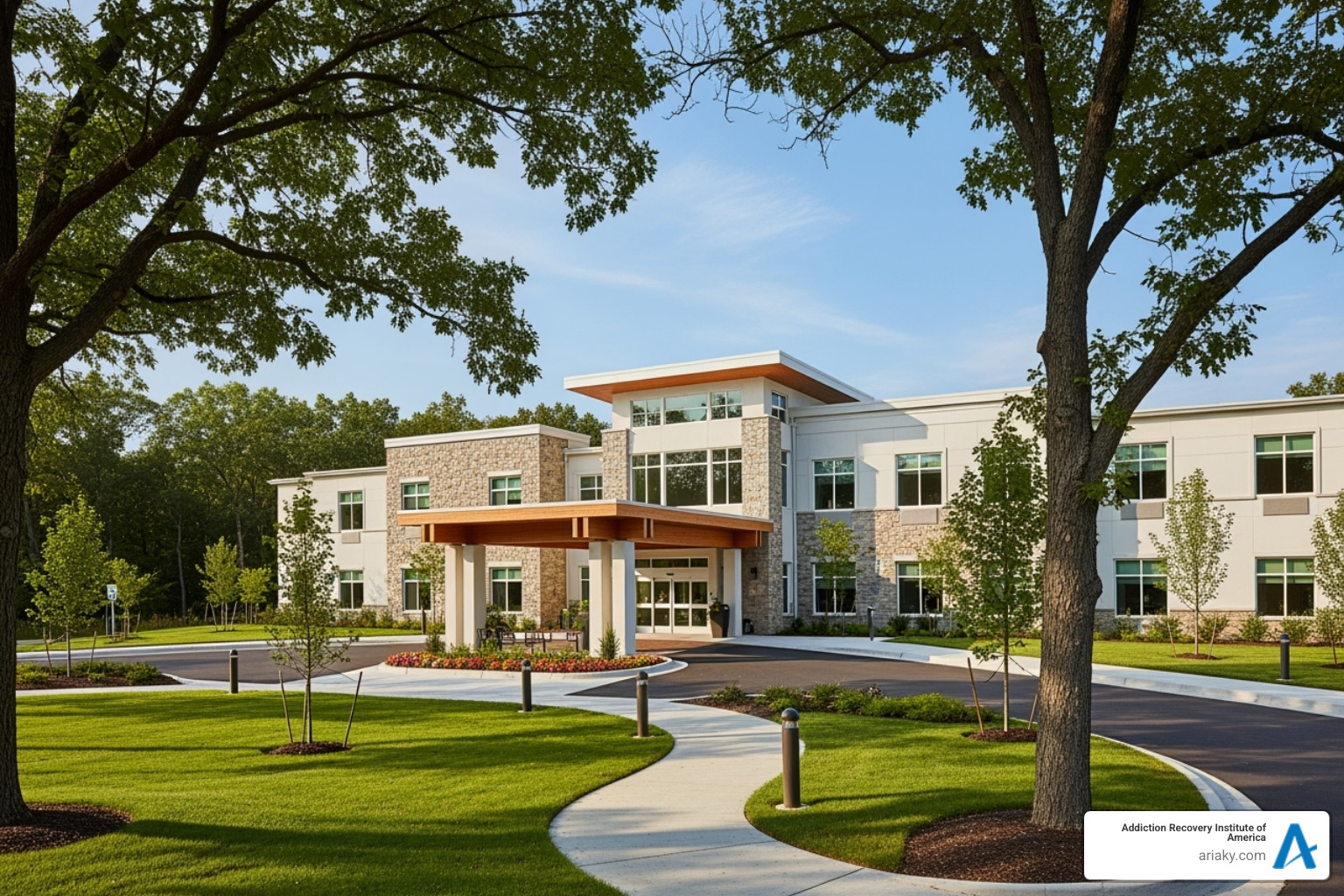Why Gender-Specific Treatment Makes All the Difference
Men’s drug rehab programs address the unique challenges men face in addiction and recovery. Research shows men are more likely than women to use almost all types of illicit drugs and have higher rates of overdose deaths. They also face distinct barriers to seeking help, including societal pressure to appear strong and stigma around showing vulnerability.
Quick Facts About Men’s Drug Rehab:
- Higher Risk: Men are 2-3 times more likely to develop substance dependence than women
- Different Substances: Men show higher rates of alcohol, marijuana, and heroin use
- Treatment Barriers: Social expectations make it harder for men to seek help
- Better Outcomes: Gender-specific programs can improve engagement and retention rates
- Specialized Care: Men-only settings allow for focused treatment of male-specific issues
Men often begin using substances earlier than women, frequently due to peer pressure or risk-taking behaviors. They also tend to experience more severe alcohol withdrawal symptoms and suffer greater adverse consequences from substance abuse.
Statistics show that men accounted for 63.9% of treatment service events and represent the majority of both opioid and stimulant overdose deaths. Despite these numbers, many men struggle to seek help due to shame and societal expectations to handle problems alone.
Gender-specific rehab programs create a safe space where men can openly discuss their struggles without judgment. These programs eliminate romantic distractions, foster deeper peer connections, and address issues like anger management and trauma that commonly affect men in recovery.
This guide will help you understand the benefits of men’s drug rehab, what to expect, and how to choose the right program for lasting sobriety.

Why Gender Matters: Unique Addiction Challenges for Men
Men are often told to “tough it out,” but this message can become a barrier to addiction treatment. Understanding gender differences is essential for effective care.
Men face unique pressures that shape their addiction journey. Society expects men to be stoic and self-reliant, which can lead them to turn to substances to cope while maintaining a “strong” exterior. Instead of reaching out, many men use substances to manage overwhelming feelings.
Biological differences also play a crucial role. Men’s bodies process substances differently, leading to distinct patterns of use. Research shows men are more likely to engage in risk-taking behavior and respond more strongly to peer pressure, especially during their teenage years when substance use often begins.
These factors combine with higher rates of co-occurring disorders like depression and PTSD. When these mental health challenges go untreated, they fuel the addiction cycle. Men also show different substance preferences, gravitating more toward alcohol, marijuana, and stimulants.
The stigma around seeking help is particularly deep for men. Admitting you need support can feel like admitting weakness, which goes against societal teachings about masculinity. This keeps many men from entering men’s drug rehab until their addiction has progressed to dangerous levels.
Understanding these unique challenges is the first step toward finding effective treatment. Sex and gender differences in substance abuse research continues to show why specialized approaches work better than one-size-fits-all solutions.
How Addiction Experiences Differ for Men
Statistics show men are significantly more likely to use almost every type of illicit drug compared to women. The gap is even more striking with alcohol use, as men are three to four times more likely to develop problem drinking and alcoholism.
Men also experience higher rates of overdose deaths, particularly from opioids and stimulants. Emergency room visits related to substance use are also more common among men, often reflecting riskier patterns of use and a tendency to delay seeking help until a crisis occurs.
The earlier onset of substance use among men creates additional challenges. Many start experimenting in their teens, viewing it as a rite of passage. This early exposure gives addiction more time to become entrenched.
Men also tend to have higher rates of antisocial personality disorder alongside their addiction, which can complicate treatment. However, research shows that when men do engage in treatment, they may have longer periods of abstinence between relapses compared to women.
Signs a Man May Need Professional Addiction Help
Recognizing when a man needs help can be difficult, as they are often taught to hide their struggles. Men may become experts at masking their addiction, making it harder for loved ones to spot the warning signs.
Neglecting responsibilities is often one of the first visible signs. This includes missing work or family events, neglecting household duties, and declining work performance.
Relationship conflicts tend to escalate as addiction progresses. Arguments become more frequent, trust erodes, and men may become defensive or withdraw from loved ones.
Increased secrecy becomes a survival mechanism. Hiding substances, lying about whereabouts, or being evasive about activities are all red flags. This dishonesty often extends to financial issues, with unexplained expenses or borrowing money to fund their habit.
Perhaps most telling are failed attempts to quit. When someone repeatedly tries to stop using but can’t, it indicates professional help is needed. Experiencing withdrawal symptoms like tremors, sweating, or anxiety when trying to stop is a clear sign of physical dependence.
Loss of interest in hobbies is another red flag. When substances become more important than activities, relationships, or goals, it’s time to consider professional treatment options like men’s drug rehab programs.
If you recognize these signs in yourself or a loved one, reaching out for help is the first brave step toward getting your life back.
The Benefits of a Specialized Men’s Drug Rehab Program

In a men’s drug rehab program, men find a uniquely healing environment. Surrounded by peers who understand the pressures of being a provider and the shame of addiction, they can lower their emotional walls. In this setting, conversations about fears, guilt, and struggles with anger happen naturally because everyone in the room understands.
These specialized programs aren’t just about removing women from the equation. They’re about creating a space where men can be vulnerable without feeling judged. The benefits go beyond comfort, as research shows men in gender-specific programs have higher engagement rates and are more likely to complete treatment. The camaraderie that develops becomes a powerful force for healing.
Creating a Focused and Judgment-Free Healing Environment
In co-ed facilities, romantic distractions can complicate early recovery. A men-only setting eliminates this, allowing men to focus entirely on the hard work of getting sober.
More importantly, a men-only environment fosters a level of trust and openness that is often difficult to achieve otherwise. Men can discuss sensitive topics like domestic violence, sexual trauma, or feelings of inadequacy without worrying about how they’ll be perceived. They can express fear and admit mistakes in a space that feels safe.
This environment helps redefine what healthy masculinity looks like. Instead of the “tough it out” mentality, men learn that real strength comes from vulnerability, asking for help, and supporting others. They find that admitting a problem isn’t weakness—it’s the first step toward reclaiming their life.
The Power of Peer Support in a Men’s Drug Rehab
When men share their stories with others who’ve walked similar paths, the shared experiences create an instant bond. Whether it’s the shame of drinking alone or the fear of losing custody of children, these common threads weave men together in recovery.
In group therapy, this mutual understanding breaks down the isolation that addiction creates. Suddenly, they’re not the only ones who’ve made these mistakes or felt this pain.
The accountability that develops is incredibly powerful. Men call each other out on excuses, celebrate victories, and provide honest feedback. These relationships often become the foundation of a sober network that extends far beyond treatment.
Men also re-learn social skills in these settings, such as how to have meaningful conversations without substances and how to build genuine connections. These skills are essential for maintaining sobriety in the real world.
Peer support often continues after treatment through alumni programs and support groups. This network becomes one of the most valuable assets in preventing relapse and building a fulfilling sober life.
What to Expect: Treatment Approaches in Men’s Rehab

Entering a men’s drug rehab program can be overwhelming, but knowing what to expect helps. The process begins with a thorough assessment of your substance use history, mental and physical health, and personal goals to create a personalized recovery plan. There’s no one-size-fits-all approach here.
The journey may begin with medical detox, a supervised process that can last from a day to over a week. Our medical team monitors you around the clock to ensure you’re comfortable and safe as your body begins to heal.
From there, many men move into inpatient residential treatment, living at the facility for 30 to 90 days or longer to focus entirely on recovery. For those needing more flexibility, outpatient programs offer intensive therapy while you live at home. These range from Partial Hospitalization Programs (PHPs) to Intensive Outpatient Programs (IOPs).
Every treatment plan follows proven Treatment approaches for drug addiction to give you the best chance at lasting sobriety.
Custom Therapies and Counseling for a Men’s Drug Rehab
The real work of recovery happens in therapy. You’ll work with counselors who understand the unique pressures men face, from workplace stress to the difficulty of asking for help.
Cognitive Behavioral Therapy (CBT) is a core treatment that changes the thoughts leading to substance use. It helps reframe negative thoughts into positive coping statements, a practical approach many men appreciate.
Dialectical Behavior Therapy (DBT) focuses on managing intense emotions, teaching skills for handling anger, sadness, or anxiety without substances. Motivational Interviewing is used when you’re ambivalent about getting sober.
For men dealing with past trauma, trauma-informed care provides a safe space to process painful memories. This may include specialized approaches like EMDR, which helps the brain reprocess traumatic memories so they are less disruptive.
Since many men entering rehab also struggle with depression, anxiety, or PTSD, dual diagnosis treatment addresses both addiction and mental health conditions together. Treating only one rarely leads to lasting recovery.
Therapy also tackles common issues for men: anger management techniques help you express frustration constructively. Communication skills training helps you state your needs without conflict. Relationship work addresses how addiction has damaged connections and how to rebuild trust.
The Role of Family and Holistic Care
Recovery isn’t a solo journey. Family therapy programs bring loved ones into the healing process. These sessions focus on understanding addiction and how everyone can support recovery without enabling.
Family members learn how to communicate effectively and rebuild trust. Family therapy gives everyone the tools to start fresh.
We also know that addiction affects your whole person. Holistic approaches address your physical, emotional, and spiritual health. Nutritional therapy helps repair the body and teaches you how food affects mood and energy.
Physical fitness is a powerful tool for managing stress and rebuilding confidence. Recreational therapy helps you refind old hobbies or find new interests that don’t involve substances.
Mindfulness and yoga are practical for managing cravings and anxiety. Learning to sit with uncomfortable feelings instead of escaping them is a game-changing skill. These practices can also help ease troubling addiction memory that can trigger relapse.
All these approaches work together to provide multiple tools for staying sober and handling life’s challenges.
Choosing the Right Program and Planning for Long-Term Sobriety

Choosing the right men’s drug rehab is a crucial decision. You need a program that feels safe, supportive, and aligned with your recovery goals.
The first things to look for are credentials that show a facility meets high standards. Accreditation from CARF (Commission on Accreditation of Rehabilitation Facilities) or the Joint Commission indicates the program meets strict quality requirements. These represent a commitment to excellent care.
You’ll also want to ensure the facility has licensed staff with experience in gender-focused treatment. The team should be able to handle dual diagnosis situations, treating both addiction and co-occurring mental health conditions.
A strong continuum of care is also essential. This means the program guides you from detox through residential treatment, outpatient care, and into comprehensive aftercare planning. Recovery is a marathon that requires ongoing support.
Key Factors in Selecting a Rehab Facility
When researching facilities, consider what matters most to you. The program philosophy should resonate with your values, whether it’s 12-step focused, evidence-based, or holistic.
Staff qualifications are critical. Don’t hesitate to ask about their credentials and specific experience with men’s addiction treatment.
Location is another important consideration. Some men prefer to stay close to home for family support, while others find a fresh start away from familiar triggers is more effective. Kentucky offers excellent treatment options in various settings.
While amenities aren’t the primary concern, they can contribute to your comfort. A fitness center or outdoor spaces might be important to your recovery plan.
Cost and insurance verification is a practical step, but don’t let it be the only factor. Quality programs have admissions teams to help you steer coverage and payment options. The investment in your recovery is one of the most valuable you’ll ever make.
Finally, client testimonials can provide real insight into the experience at a facility. Hearing from other men who have walked the same path can be reassuring.
Life After Rehab: Ensuring a Lasting Recovery
Completing a men’s drug rehab program is a major achievement, but it’s just the beginning. The real work starts when you return to the world and its daily challenges.
That’s why relapse prevention strategies are so important. In treatment, you’ll learn practical tools and coping mechanisms to handle triggers, stress, and difficult emotions.
Building “Recovery Capital” is essential for long-term success. This refers to all the resources, relationships, and skills you can draw on when times get tough, from a safe place to live to meaningful work.
Sober living options can provide a bridge between intensive treatment and full independence, offering structure and accountability as you rebuild your life.
Alumni programs connect you with a network of people who understand your journey and can offer ongoing support.
Ongoing therapy and support groups like Alcoholics Anonymous (AA) and Narcotics Anonymous (NA) provide regular check-ins for your recovery. These aren’t signs of weakness—they’re signs of wisdom.
Community-based recovery meetings help you build a local network of sober friends and mentors. Recovery isn’t meant to be a solo journey; these connections can make all the difference.
Frequently Asked Questions about Men’s Addiction Treatment
It’s normal to have questions when considering men’s drug rehab. Understanding what to expect can make you feel more confident about taking this important step. Here are some of the most common questions we hear.
How long does men’s rehab typically last?
There’s no one-size-fits-all answer. The length of your stay in men’s drug rehab depends on several factors, including addiction severity, substances used, and any co-occurring mental health conditions.
Medical detox is often the first step and can take from 24 hours to a week or more, depending on the substance.
Inpatient residential treatment programs typically run for 30, 60, or 90 days. Many men find that a longer stay provides a stronger foundation for recovery. Extended care options can last six months to a year for more complex cases.
Outpatient programs like PHPs and IOPs offer flexibility and can run for several months. They are often used as a step-down from inpatient care or as a primary treatment option.
Recovery is a marathon, not a sprint. Taking the time you need upfront can prevent the need for multiple treatment episodes later.
How are co-occurring mental health disorders addressed in men’s rehab?
Many men with addiction also struggle with depression, anxiety, or PTSD. Quality men’s drug rehab programs offer dual diagnosis or integrated treatment to address both issues together. Treating one while ignoring the other is rarely effective, as they often fuel each other.
Our integrated approach means you’ll work with a team of psychiatrists, therapists, and addiction counselors who collaborate on your care. Psychiatry services can help with medication management, while specialized therapy addresses underlying mental health conditions.
As your mental health improves, your recovery becomes stronger, and as you build sobriety skills, you often feel better emotionally. This simultaneous treatment is crucial because untreated mental health conditions are a major risk factor for relapse.
Is my privacy protected during addiction treatment?
Absolutely. Your privacy is protected by federal law. HIPAA laws ensure your personal health information remains confidential, and our staff adheres to strict confidentiality standards.
This means we cannot share details about your treatment with anyone—including family or employers—without your written consent. Exceptions are very limited and clearly defined by law, such as an immediate threat to safety.
We understand that men worry about their reputation and job security. Rest assured that seeking help is a private matter. This confidentiality allows you to focus entirely on your recovery without fear of judgment or unwanted exposure. Involving others in your recovery journey is your choice and happens on your terms.
Your Path to Recovery Starts Today
Understanding men’s unique addiction challenges is the first step to meaningful recovery. As this guide has shown, societal pressures and other factors create distinct barriers for men. Gender-specific care addresses these challenges directly, creating an environment where real healing can happen.
Men’s drug rehab programs are not just about removing distractions—they’re about creating a space where vulnerability becomes a strength. When men can openly discuss their struggles without fear of judgment, the real work begins. The benefits of seeking help in a supportive, understanding environment are immense.
Recovery is possible, and it starts with taking that first brave step. At the Addiction Recovery Institute of America (ARIA), we understand the courage it takes to ask for help. Our accredited, AODE-certified centers provide the individualized, evidence-based care men need to build lasting sobriety.
Whether you’re in Kentucky, Ashland, Bowling Green, Covington, Florence, Lexington, Louisville, Morehead, Newport, Owensboro, or Paducah, we are here to support you. Our team is committed to walking alongside you on your unique journey.
Hope for recovery isn’t just a promise—it’s a reality we see every day in the men who complete our programs and go on to rebuild their lives.


